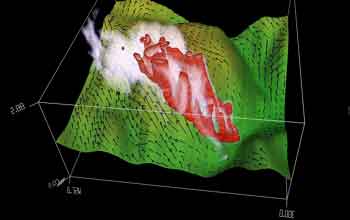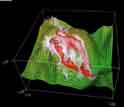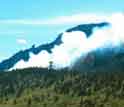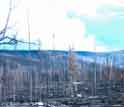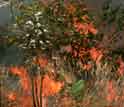|

Press Release 04-042
Researchers Receive Funds to Create High-Tech Wildfire Fighting Solutions

April 15, 2004
Arlington, Va.—Frontline fire fighting could soon go high tech. In the not so distant future, analysts using supercomputers may be able to send real-time maps and predictions of a wildfire's next moves to wildfire management teams hundreds of miles away. That crucial information could be passed on to palm pilots and other wireless devices in the hands of frontline firefighters deciding how best to battle the blaze.
With millions of dollars in property and millions of acres in the American West burned by devastating wildfires in recent years, researchers at the University of Colorado at Denver, the University of Kentucky, Texas A&M University, Rochester Institute of Technology, and the National Center for Atmospheric Research (NCAR) in Boulder, Colo. are working together to develop state-of-the-art information tools and apply them to wild land fire.
This team has been awarded $2 million to develop an advanced, computer-generated, dynamic, data-driven system that will predict wildfire behavior and progression. The four-year project, funded by the National Science Foundation (NSF), will use the most recent advances in computer speed and power, high-speed information networks, satellite and sensor monitoring, mathematical theory and meteorology to develop tools to warn firefighters about where a fire may go and sudden changes that might occur, such as wind changes or extreme fire behavior.
"The project implements the concept of Dynamic Data Driven Applications Systems to enhance traditional wildfire modeling methods by dynamically integrating real-time and archival data into the executing simulations; such capabilities will have a major impact on our ability to contain fires, and minimize harm to humans and the environment," said Frederica Darema, Senior Science and Technology Advisor in NSF's Computer and Information Sciences Directorate, which is funding the project.
Called the Data Dynamic Simulation for Disaster Management Project, it's team is headed by CU-Denver mathematician Jan Mandel, who will work with a coupled weather and wildfire computer model developed at NCAR to build a software system that will use data from the fire scene to determine wildfire-spread scenarios and probabilities.
The grant will allow the team to create a system where multiple sensors placed around a wildfire will continuously send input such as temperature, wind direction and speed and the moisture in grass and sticks to a high-end research computer known as a supercomputer.
The supercomputer will use the mathematically based wildfire model to continuously send maps and forecasted fire locations to the front lines in real time, allowing a fire manager to see minute-by-minute predictions or anticipate where fire growth will occur along the fireline. The system may also allow fire managers to plan the most effective and efficient actions, for example by foreseeing situations where weather, the terrain, fuels and winds created by the fire would combine to create a fire that would grow rapidly unless more resources were used to stop it early on. The system might also be used to identify situations where wildfires can be allowed to spread harmlessly under controlled conditions for hazardous fuel reduction and natural resource benefits.
The efforts of the team will eventually be put to the test. In four years, they are scheduled to take the technology to a real wildfire.
Said Mandel, "In the past, running a model on a computer meant starting a simulation and then waiting for the results. It is time to change the way scientific modeling is done. In a movie, you may see a computer on a starship, and the computer takes into consideration new information as soon as it comes. This is how computers work in the imagination of movie directors, and this is how people expect computers should work. Our project will help make this a reality."
Wild land fires are a devastating force driven by complex phenomena that are not well understood. Scientists at NCAR have a history of coupling numerical regional weather simulations with fire-spread models to advance the understanding of wildfires.
According to NCAR scientist Janice Coen, "There are many things about wildfires that aren't understood scientifically. But there are also a lot of technological challenges to simulating phenomena that change very rapidly, and in quickly transmitting data from remote locations into a model running many possible scenarios on a supercomputer very far away. You have to deliver this information rapidly, reliably and in a meaningful way (with images, not words) through secure means to people who may be far from telephones. Those are the information technology problems this research addresses, and they occur in management of other natural and human caused disasters as well."
-NSF-

Media Contacts
Cheryl Dybas, NSF (703) 292-7734 cdybas@nsf.gov
Anatta , UCAR (303) 497-8604 anatta@ucar.edu
Michele Ames, Univ. of Colorado at Denver (303) 556-2523 michele.ames@udenver.edu
Program Contacts
Frederica Darema, NSF (703) 292-8950 fdarema@nsf.gov

The National Science Foundation (NSF) is an independent federal agency that supports fundamental research and education across all fields of science and engineering. In fiscal year (FY) 2009, its budget is $9.5 billion, which includes $3.0 billion provided through the American Recovery and Reinvestment Act. NSF funds reach all 50 states through grants to over 1,900 universities and institutions. Each year, NSF receives about 44,400 competitive requests for funding, and makes over 11,500 new funding awards. NSF also awards over $400 million in professional and service contracts yearly.
 Get News Updates by Email Get News Updates by Email
Useful NSF Web Sites:
NSF Home Page: http://www.nsf.gov
NSF News: http://www.nsf.gov/news/
For the News Media: http://www.nsf.gov/news/newsroom.jsp
Science and Engineering Statistics: http://www.nsf.gov/statistics/
Awards Searches: http://www.nsf.gov/awardsearch/
| 

